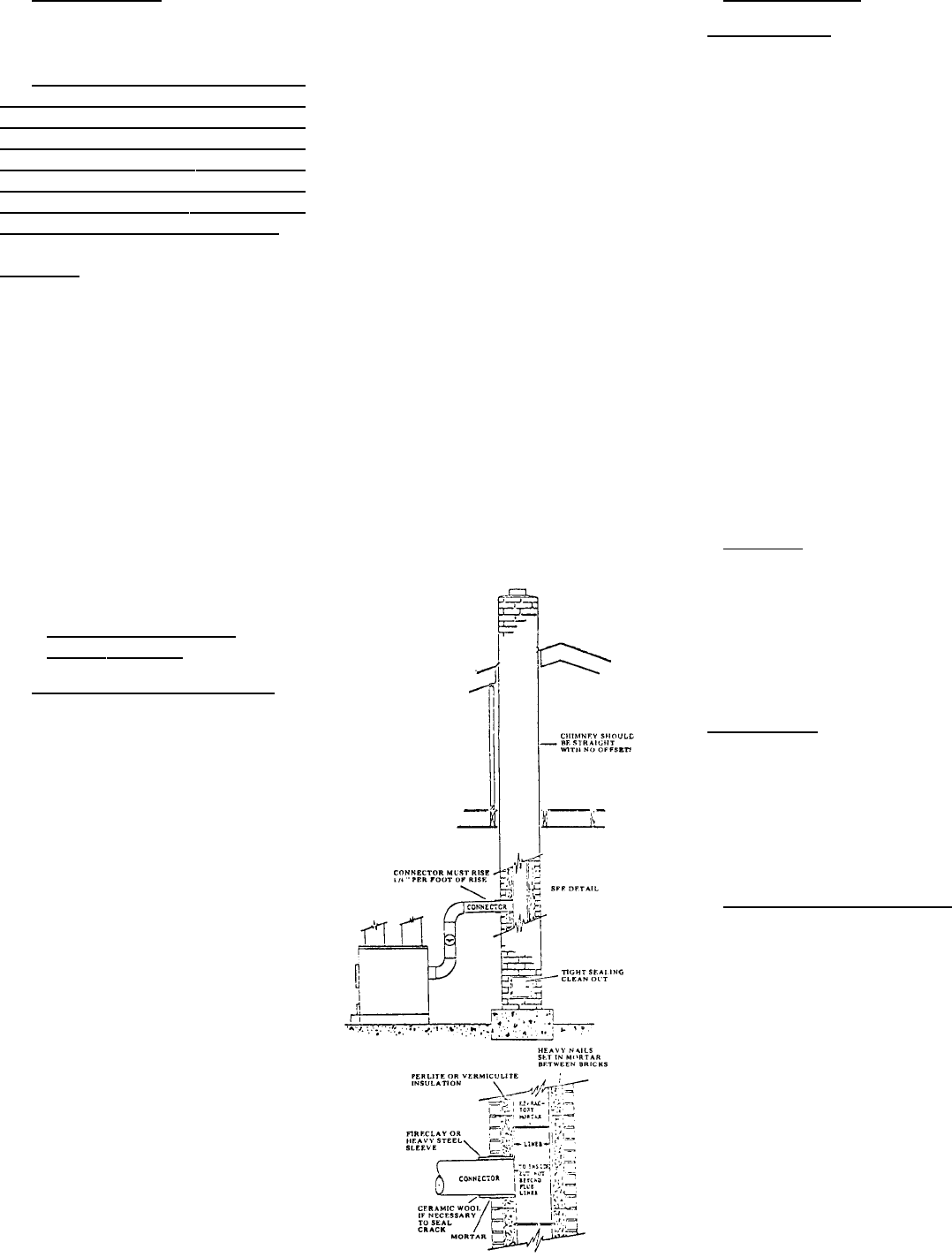
4
H. Multiple Venting - No more than
one device shall vent into the same
chimney flue.
THE MOST IMPORTANT THING
TO REMEMBER ABOUT CHIMNEYS
IS THEIR NEED FOR MAINTENANCE
AND CLEANING. IF CHIMNEYS ARE
N O T CLEANED ON A F R E Q U E N T
BASIS. IT WILL AFFECT THE DRAFT,
AS WELL AS BEING A CONTRIBUT-
ING CAUSE TO A CHIMNEY FIRE.
CAUTION
ANYTIME YOU HAVE A CHIMNEY
FIRE THE FOLLOWING POINTS
SHOULD BE OBSERVED:
1. BE SURE EVERYONE IS OUT
OF THE HOUSE.
2. C A L L THE FIRE DEPA RT-
MENT.
3. CLOSE DOWN DRAFT
DAMPER ON STOVE.
AFTER THE FIRE IS EXTIN-
GUISHED, DO NOT USE THE CHIM-
NEY UNTIL A QUALIFIED PERSON
HAS INSPECTED YOUR CHIMNEY.
3.3 What To Do When You
Have A Problem
A. Smoke Puffs From Your Stove:
1. Check the chimney draft. With
a good fire burning, the chimney should
supply .06" updraft.
2. Check draft controls for proper
operation.
3. Check the smoke pipe and be
sure it is clean.
4. Chimney may be too low.
Increase the height. Make sure the
chimney is structurally sound.
5. Add more air to the room. Your
home may be so airtight that not
enough oxygen is reaching the fire.
6. REMEMBER, open the draft
controls and crack the fire door slightly
before recharging the fire chamber or
checking the fire.
SPECIAL WARNING: NEVER OPER-
ATE YOUR STOVE WITH THE FIRE
OR ASH DOOR OPEN!
7. Check the smoke pipe and
make certain each joint is tight and the
connections to the stove and chimney
are airtight.
8. Check the ashes. Ashpan and
fire compartment may be overloaded
with ashes.
9. Check your chimney for down
drafts. This is caused by air currents
being deflected down the chimney from
higher objects, such as trees, buildings
and hills. This problem can usually be
corrected with an open-vented chimney
cap.
10. Make sure the chimney
cleanout door is tightly closed and
sealed.
11. If other fuel-burning devices
are connected to the chimney they may
be causing draft problems. This must
be corrected by your heating contrac-
tor.
3.4 Chimney Details
Chimney Liners - Most of the cus-
tomer inquiries received are problems
caused by poor, or in some cases,
excessive draft. A result of poor draft
could be creosote, backpuffing, and
smoky firebox when loading.
Indications of excessive draft are burn-
ing too much fuel and high stack tem-
peratures.
The most common cause of poor
draft is an improperly sized flue liner.
We recommend that the chimney
liner’s inside dimensions be at least as
large as the appliance’s collar size.
TO SUMMARIZE, A H E AT I N G
UNIT CAN PERFORM ONLY AS WELL
AS ITS VENTING SYSTEM WILL
ALLOW IT.
4. Electrical
4.1 Warnings
Turn off electric power at fuse box
or circuit breaker panel before making
any line voltage connections. Follow
local electrical codes. Be sure to route
power so that it doesn’t come in contact
with the stove.
I M P O RTA N T ! A L L W I R I N G
SHOULD BE DONE IN A C C O R-
DANCE WITH LOCAL AND STAT E
CODES.
5. Grates
5.1 Grate System and Controls
A. Heavy-Duty Cast Iron Grate
System - The functions of a grate sys-
tem are to support the coal and at the
same time provide air flow through the
grates to the coal. Harman grates have
a maximum amount of air flow to pro-
duce an even burning fire. Another
function is to remove the ash from the
unburned coal by grinding, breaking or
shaking them until the ashes fall
through the grates. Harman grates pro-
vide a variable amount of grinding
action controlled by the movement of a
long shaker-lever located on the left
side of the stove. Grates are removable
without tools.

















